Grandma & Koro’s (2nd) Great Adventure
Kaliméra,
Today was a big day. Today we visited the Acropolis, the heart of Athens, and arguably the birth place of Western Civilisation.
The Acropolis is a huge rocky outcrop, right in the centre of the the city of Athens. You can see it from just about anywhere in Athens. This rocky outcrop was naturally easy to defend from attackers, so it was fortified.
Legend has it that two gods, Athena (daughter of Zeus and goddess of wisdom) and Poseidon (god of the sea), argued over the which one of them should be the patron of the new city. To settle the argument, Zeus said Athena and Poseidon could each present a gift to the citizens, and the gift the citizens appreciated the most would decide the winner of the contest.
Poseidon used his trident to pierce the ground of the Acropolis, and where it struck the ground a water spring started to flow. The citizens were delighted, until they tasted it and the water was salty. Salt water is no good for either drinking or watering crops.
Athena used her spear to strike the ground, and from where it struck an olive tree grew. The citizen’s loved the olive tree as it provided food, oil and firewood, so Athena won the right to be the patron of the city of Athens, and the city was named after the after the goddess.
Day 34
Athens - The Acropolis
Kaliméra,
Today was a big day. Today we visited the Acropolis, the heart of Athens, and arguably the birth place of Western Civilisation.
The Acropolis is a huge rocky outcrop, right in the centre of the the city of Athens. You can see it from just about anywhere in Athens. This rocky outcrop was naturally easy to defend from attackers, so it was fortified.
Legend has it that two gods, Athena (daughter of Zeus and goddess of wisdom) and Poseidon (god of the sea), argued over the which one of them should be the patron of the new city. To settle the argument, Zeus said Athena and Poseidon could each present a gift to the citizens, and the gift the citizens appreciated the most would decide the winner of the contest.
Poseidon used his trident to pierce the ground of the Acropolis, and where it struck the ground a water spring started to flow. The citizens were delighted, until they tasted it and the water was salty. Salt water is no good for either drinking or watering crops.
Athena used her spear to strike the ground, and from where it struck an olive tree grew. The citizen’s loved the olive tree as it provided food, oil and firewood, so Athena won the right to be the patron of the city of Athens, and the city was named after the after the goddess.
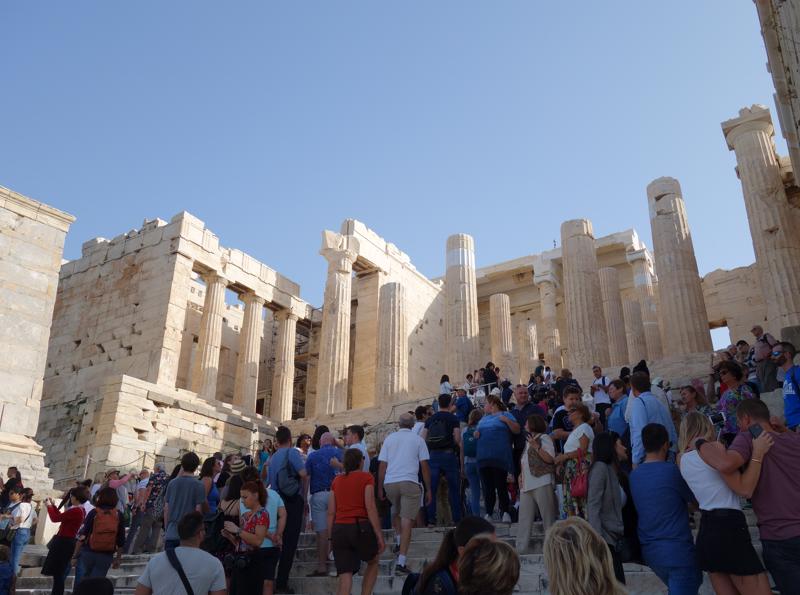
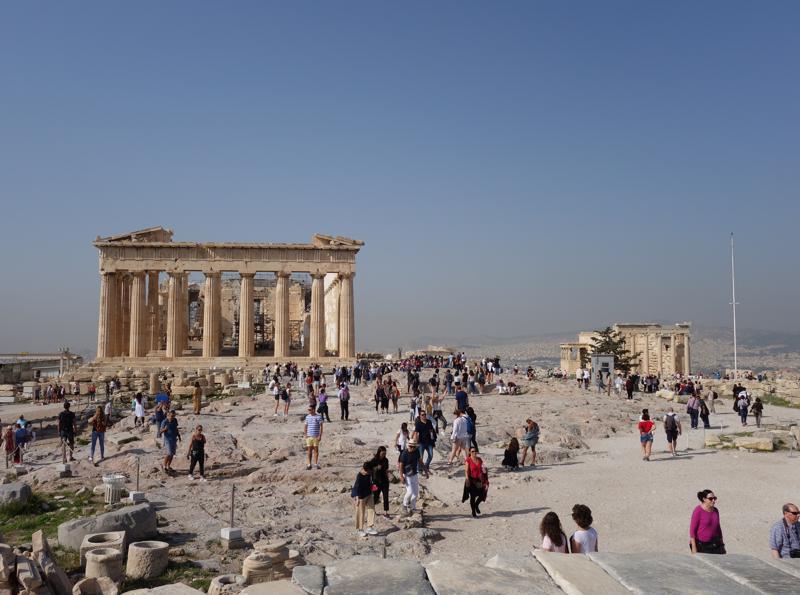
The Acropolis was an area for worship, intellectual thought and debate. This is the area where people like Plato and Socrates used to hang out, thinking deep and meaningful thoughts and then carving those thoughts into a stone tablet.
The people of Athens built many fantastic buildings on the Acropolis, the most famous of which is the Parthenon, a temple to the goddess Athena. This was a huge temple, built to house an immense statue of the goddess. Made of gold and ivory, the statue was reportedly 9 metres tall and very beautiful.
Unfortunately the centuries have not been kind to the buildings of the Acropolis. The statue of Athena was said to be taken by a Roman Emperor, Zeno, to the city of Constantinople (the city is called Istanbul these days). It is thought to have been destroyed during the crusades in about 1204AD.
The Parthenon stood for many years. In 1687 the Ottomans were using it as a storehouse for gunpowder and munitions. A direct hit from a cannonball fired by the Venetian army blew up the gunpowder, the resulting explosion destroying a large part of the building, including the roof.
In 1801 the British ambassador to Constantinople, the Earl of Elgin, used a document of questionable authenticity to remove some of the sculptures from the Acropolis and take them back to England. Today they are held by the British Museum in London, but Greece would very much like to have them back.
Today, with financial help from the European Union, the treasures of the Acropolis are being cared for and restored. The Temple of Nike

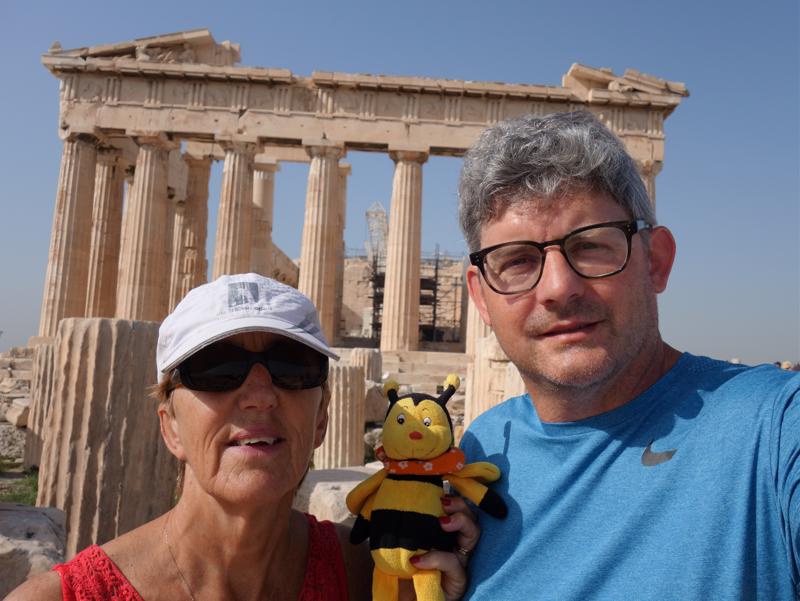
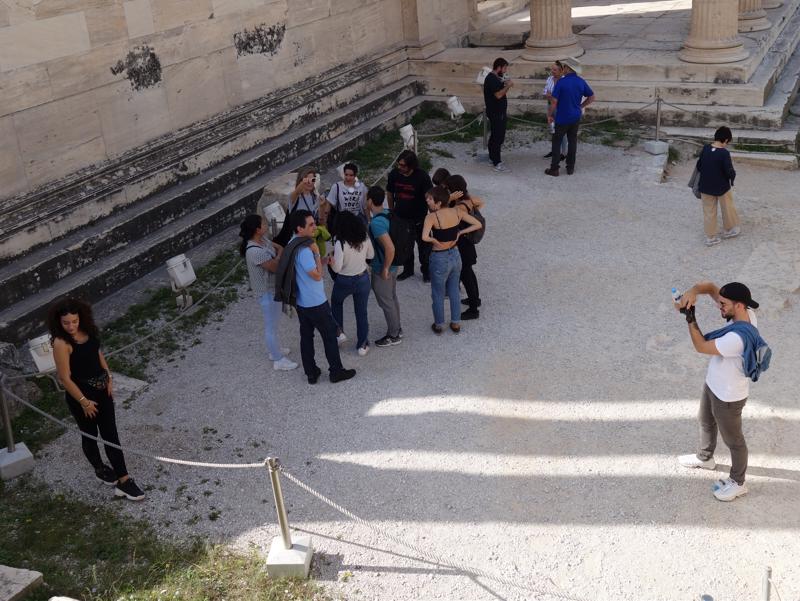

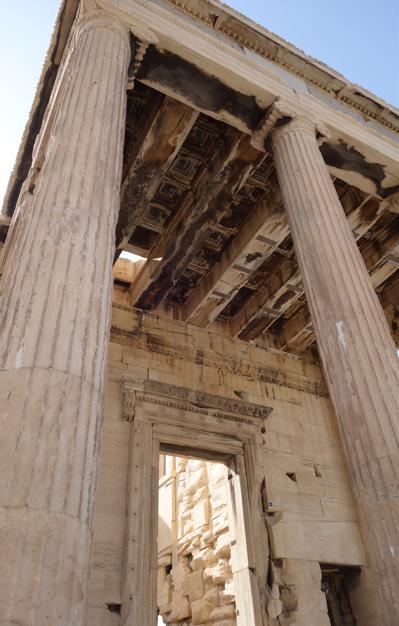
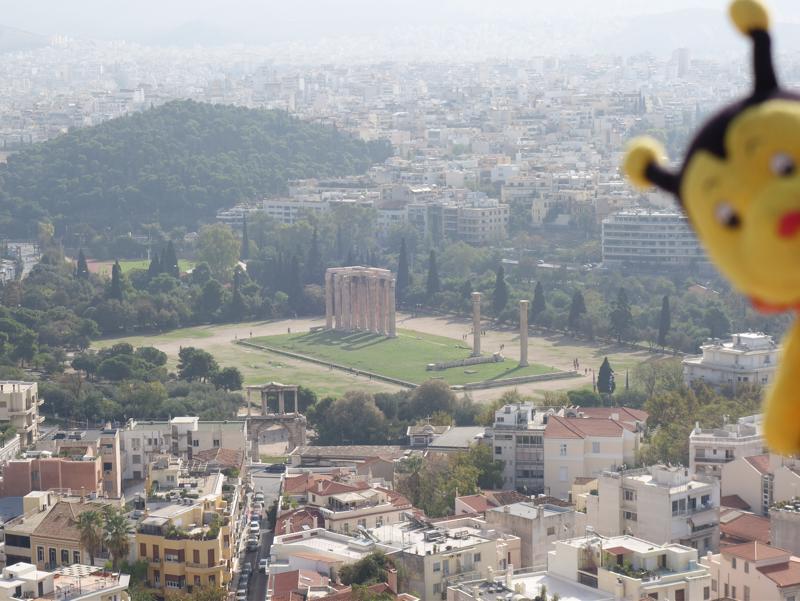
has been restored using the original blocks, and where these could not be found, artificial stone fills the gaps. Work is also being done on the Parthenon, and you can see the scaffolding in the pictures.
The site attracts large numbers of visitors. We arrived early and were able to go straight in after buying our tickets. By the time we left the queue to buy tickets was about an hour long. And this is not the busy season of July and August.
Despite the numbers of people, the site was immaculately clean. We did not see any litter anywhere like you do in sites in Roma or Venezia. It is a real credit to the people of Greece how clean they do keep their beautiful country, at least what we have seen of it so far.
There were also plenty of Acropolis staff located at various places to make sure visitors stayed off the monuments and didn’t try and steal anything. It is forbidden to remove any rocks or stones from the Acropolis. What looks like a broken rock, could well be part of a sculpture.
The staff were serious too. Whenever someone went somewhere that was forbidden the staff would blow a very shrill whistle and start shouting. Unfortunately, there were plenty of silly people trying to climb up onto plinths or over ropes just to try and get a better picture.
Buzzy Bee thought the Parthenon was fantastic, and the view of Athens spectacular. It was a beautiful sunny day and we were in a magical location. There were many people posing and getting shots to add to their social media portfolio, and Mr Bee was certainly no exception. And that was when The Incident occurred.
While he was flying high over Athens, one of the Acropolis staff
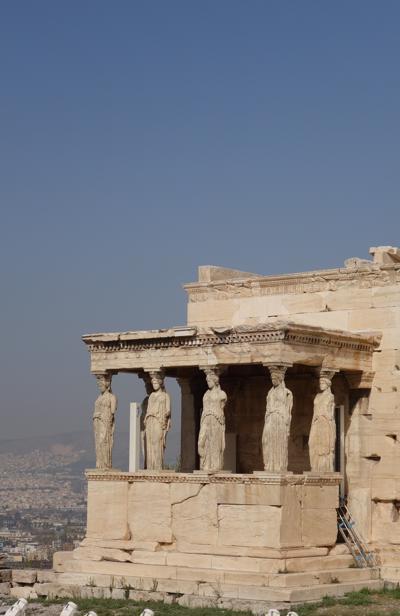
suddenly walked up to us and said, “You have to put your Teddy Bear in your bag, you can’t take pictures of Teddy Bears on the Acropolis.”
Teddy Bear?
Grandma thought the man was joking, so she said, “Oh no, he’s not a Teddy Bear, he’s a bee and he’s all the way from New Zealand.”
But the man was not joking. “Teddy Bears are not allowed on the Acropolis”, he said firmly..
Buzzy Bee was incensed, and quite prepared to sting this silly man. The only reason he hesitated was because he couldn’t work out which was worse, being called a Teddy Bear, or being told he wasn’t allowed on the Acropolis.
We managed to stuff him back into Koro’s backpack, but there was a furious buzzing coming from the backpack for the rest of the morning.
In the afternoon we visited the Acropolis Museum. This museum opened in 2007, and it is a spectacular building. The building itself is a beautiful piece of modern architecture. It was built over an archaeological site, a very old urban settlement. Huge concrete columns suspend the whole building over the archeological site. Sections of the ground floor are made of glass, and you can walk over the old site and see it beneath your feet. Plans are underway to make this old site accessible to the public in the future.
Archaeologists have treated the Acropolis like a giant jigsaw puzzle, sweeping up all the broken pieces of stone, piecing them together and reassembling old statues and artifacts.
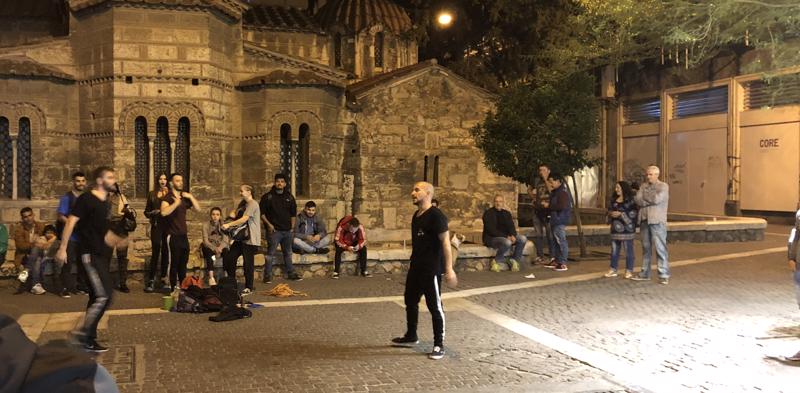
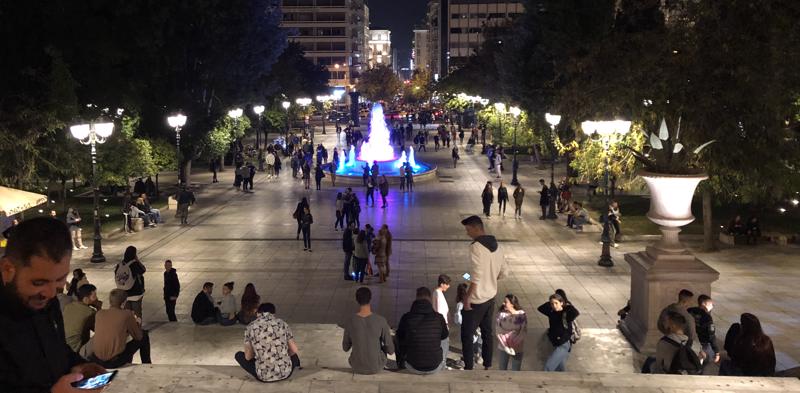
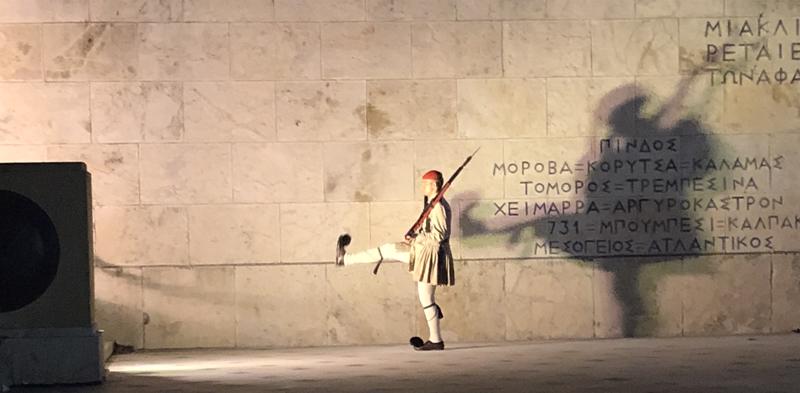
The highlight of the museum is the very top floor, which holds the stone carvings that once adorned the outside of the Parthenon. They have been reassembled and put on display in a way that everyone can appreciate the incredible craftsmanship of 2500 years ago, and also protects them from further damage.
The outside walls of the museum are made of glass, so as you walk around the top floor of the museum, the views of the Parthenon are breath taking. You can look at the Parthenon, then turn around and look at the carvings that once decorated it.
The museum was partially funded with money from the European Union, but the money has certainly not been squandered. This is a modern museum with a very clear focus, and it tells its story simply and beautifully. This is not your boring old dark wood paneling and dim lighting and acres of terra cotta pots type of place.
After a day of sight seeing we walked back to our hotel, enjoying the late afternoon sun. The streets were crowded with tourists, but it was a pleasant buzz rather than the loud and aggressive chaos that Italy can be.
Today has been a fantastic day, and so far we are really enjoying Greece. Well, most of us. Buzzy Bee is still grumbling a bit. We are sure to find other places where he can stretch his wings.
Love to you all from a Grandma and Koro and Grumpy Bee. XXX OOO.
1.
Day 1
2.
Day 2
3.
Day 3
4.
Day 4
5.
Day 5
6.
Day 6
7.
Special Update - German Toilets
8.
Day 7
9.
Day 8
10.
Day 9
11.
Day 10
12.
Day 11
13.
Special Update - The Bidet
14.
Day 12
15.
Day 13
16.
Day 14
17.
Day 15
18.
Day 16
19.
Day 17
20.
Day 18
21.
Special Update - Rick's Challenge
22.
Day 19
23.
Day 20 & 21
24.
Day 22
25.
Day 23
26.
Day 24
27.
Day 25
28.
Day 26
29.
Day 27
30.
Day 28
31.
Day 29
32.
Day 30
33.
Day 31
34.
Day 32
35.
Special Update - Parking in Sicily
36.
Day 33
37.
Day 34
38.
Day 35
39.
Day 36
40.
Day 37
41.
Day 38
42.
Day 39
43.
Special Update - The Squat Toilet
44.
Day 40
45.
Day 41
46.
Day 42
47.
Day 43
48.
Day 44
49.
Day 45
50.
Day 46
51.
Day 47
52.
Day 48
53.
Day 49
54.
Day 50
55.
Day 51
56.
Day 52
57.
Day 53 to 57 - Hong Kong
Share your travel adventures like this!
Create your own travel blog in one step
Share with friends and family to follow your journey
Easy set up, no technical knowledge needed and unlimited storage!
© 2025 Travel Diaries. All rights reserved.